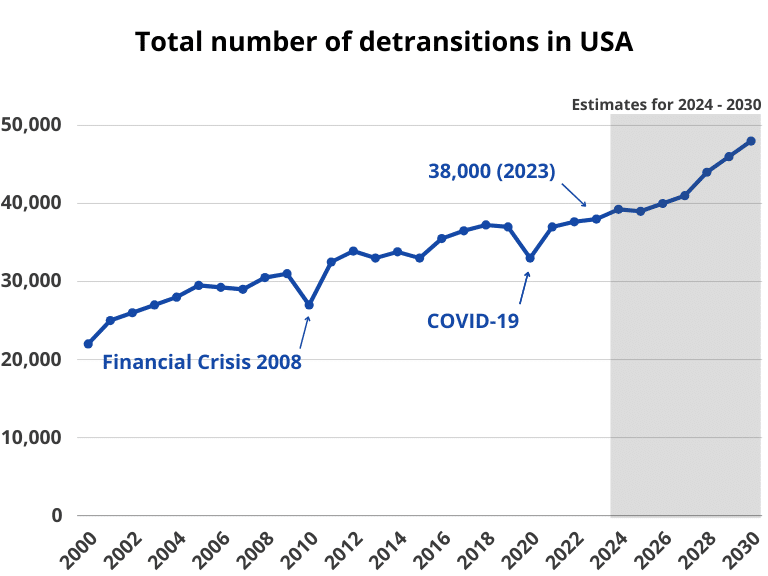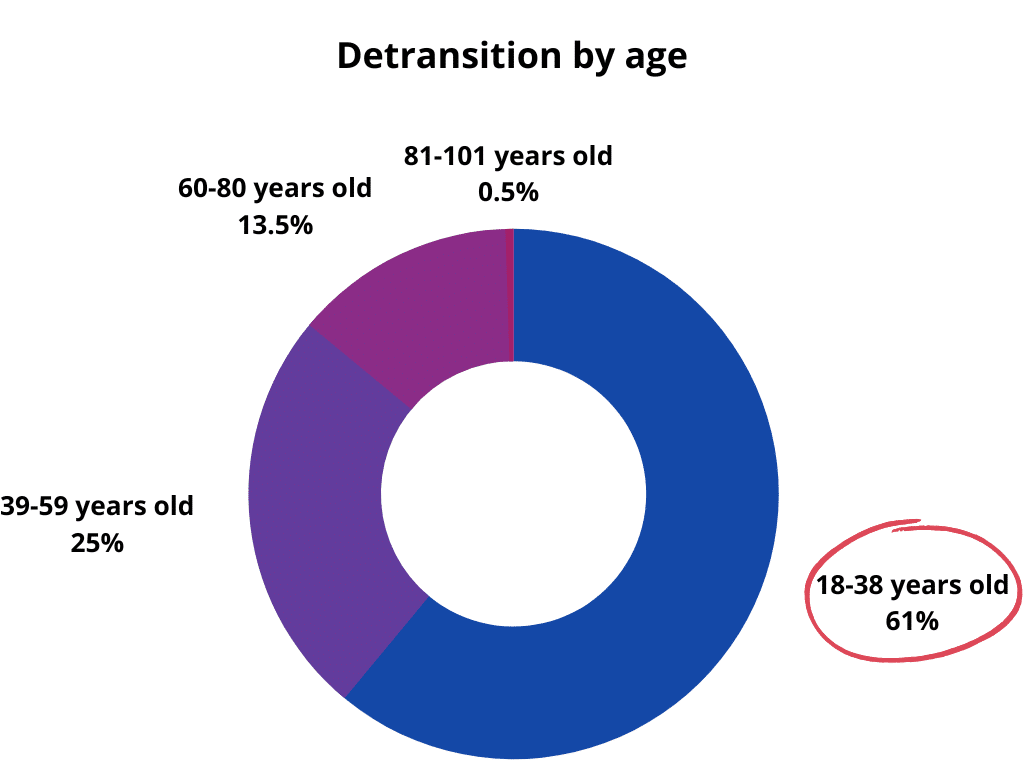![Detransition Statistics & Facts [Complete Overview]](https://wp.bedbible.com/wp-content/uploads/2023/03/Detransition-Statistics-Facts.png)
Everyone’s path of self-discovery and identity is intricate and personal, molded by a variety of experiences that are distinct to them. As of late, the subject of detransitioning has gained notice and piqued interest, creating significant discussions and questions about the intricacies of gender identity.
Keep reading as we explore the multifaceted aspects of detransitioning, uncovering insights that will challenge perceptions, foster understanding, and ignite conversation.
The following points have been covered:
- How many trans people detransition
- Detransitioners demographics
- How much does it cost to get a detransition
- Why do people start detransitioning
- Detransition Suicide Rates
Key Findings
- Detransition Rate: 1.75% of transgender individuals detransition (that’s around 38,000 people in the US every year).
- Gender Variation: Detransition rates are higher among transgender women (2.2%) than transgender men (1.3%).
- Timing: Most detransitions occur within the first five years after transitioning.
- Detransition by Age:
- Ages 18-38: 61%
- Ages 39-59: 25%
- Ages 60-80: 13.5%
- Ages 81-101: 0.5%
- Influential Factors: Major reasons include social or family pressure (83%), employment challenges (42%), and lack of support (35%).
- Methods of Detransition: Include hormone therapy, surgical revisions, therapy, legal changes, and social adjustments.
- Suicide Attempt Rate: The rate of attempted suicide in the past year was notably higher among individuals who had detransitioned, standing at 12%.
How many trans people detransition
- 1.75% of transgenders detransition (2.2% of transgender women (assigned men at birth) and 1.3% of transgender men (assigned women at birth).
- That’s 38,000 persons in the US and 700,000 persons in the world every year detransition.

Detransitioners demographics
- 72% of detransitions occur within the first five years of initiating a transition.
- 11% of detransitioners had undergone some form of gender-affirming surgery before transitioning.
- 61% of detransitioners had used hormone therapy during their initial transition.
- Detransition by age:
18 – 38: 61%
39 – 59: 25%
60 – 80: 13.5%
81 – 101: 0.5% - Countries with progressive policies towards transgender rights and access to gender-affirming healthcare have more cases of detransition, simply because more people in these countries are likely to have access to transition-related care: Examples of such countries include the United States, Canada, and several European countries, such as the Netherlands, the United Kingdom, and Sweden.
- 7 out of 10 that detransition starts with hormone therapy.
- Female detransitioners (transgender women = born male) are more likely to return as lesbians than to be straight.

How much does it cost to get a detransition
There are different ways to get a detransition we have listed the 5 most popular ones and the estimated prices for them:
Hormone Therapy: Consisting of testosterone and estrogen.
Surgical reversal or revision: Individuals may wish to reverse or revise certain gender-affirming surgeries. This could involve procedures such as breast implant removal for transgender women or breast reconstruction for transgender men, or the reversal or modification of genital surgeries.
Therapy and counseling: Detransitioning can be an emotionally challenging process, and many individuals may benefit from working with a mental health professional to navigate the emotional and psychological aspects of detransition.
Legal expenses: There may be legal expenses associated with changing one’s name and gender markers on identification documents back to their original status.
Social detransition: Some individuals may choose to detransition socially, which can involve changing their appearance, clothing, pronouns, or name back to their pre-transition state.
| Detransition expense | Cost Range |
|---|---|
| Hormone therapy | Testosterone therapy: can range from $20 to $200 per month for injections, while testosterone gels or patches can be more expensive, sometimes exceeding $400 per month. Estrogen and anti-androgen therapy: can range from $30 to $150 per month. Additionally, the cost of anti-androgen medications, such as spironolactone, can range from $10 to $50 per month. |
| Surgical reversal or revision | $5,000 – $50,000+ |
| Therapy and counseling | $100 – $250 per session |
| Legal expenses | $150 – $1,500+ |
| Social detransition | Varies |
Why do people start detransitioning
- 42% indicated that difficulties related to employment or career development had played a role in their decision to detransition.
- 9 out of 10 detransitioners cited social or family pressure as the primary factor in their decision to detransition. Only 1 out of 10 detransitions do it because it was not right for them.
| Rank | Reason for Detransitioning | Percentage |
|---|---|---|
| 1 | Social or family pressure | 83% |
| 2 | Difficulties related to employment or career | 42% |
| 3 | Lack of support | 35% |
| 4 | Financial constraints | 30% |
| 5 | Dissatisfaction with medical interventions | 25% |
| 6 | Health concerns or complications | 20% |
| 7 | Change in gender identity or self-understanding | 14% |
Detransition Suicide Rates
- The rate of attempted suicide in the past year was significantly higher among individuals who had de-transitioned at 12% compared to those who had not “de-transitioned” at 6.7%.
